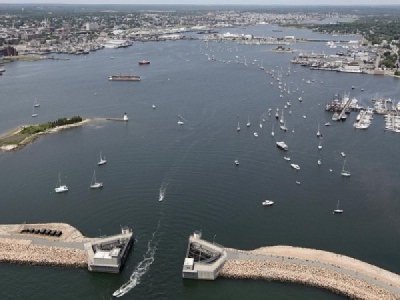
Posted on April 11, 2017
By Jennette Barnes, SouthCoastTODAY
Better access to maritime shipping and rail service would go a long way toward boosting economic development in the port of New Bedford, local observers said in response to a new report on the state’s maritime economy released Tuesday.
The maritime industry grew an inflation-adjusted 37 percent from 2005 to 2015, more than triple the rate of the Massachusetts economy as a whole, according to the report from the Public Policy Center at UMass Dartmouth, commissioned by the Seaport Economic Council.
New Bedford is one of the few full-service ports in New England, where vessels can get welding, fuel, and other services, according to David Borges, director of research and administration for the Public Policy Center. Dredging the harbor would allow it to accept more shipping traffic, he said.
A Fairhaven official agreed. Bill Roth, planning and economic development director for the town, said that although Fairhaven’s waterfront is mostly residential, dredging would benefit the Fairhaven Shipyard, and the town has been working with New Bedford and the Harbor Development Commission on dredging plans.
“The amount of money spent on dredging, we reap in economic development,” he said.
The navigational channel has not been dredged to its authorized depth in more than 50 years, according to an economic impact study completed last fall for the Harbor Development Commission.
Infrastructure to move products is increasingly important, Borges said. Businesses like fish processors once located near the water to get access to the product, but proximity is less important than it used to be. In Boston, access to transportation by air, water, and rail is critical, he said.
New Bedford Port Director Edward Anthes-Washburn said bringing rail service south of the Eversource property to South Terminal would help. Fish processing has become more dependent on logistics than ever, he said.
The report also says harbor-area zoning should be flexible to support more varied development of waterfronts. Although the state has 10 ports deemed Designated Port Areas to promote and protect water-dependent industrial uses, some cities are looking to redevelop land to move toward more “innovation-oriented” maritime industries, such as research and education, the report says. Some are also looking to include mixed-use development and more public spaces.
“The ability to do so will require more flexibility than is currently permitted,” the report says.
With regard to varied development, Borges said some people have told him, “Be careful what you wish for,” because although tourism is by far the largest sector of the marine economy in terms of employment, traditional marine industries remain a large part of the local heritage and identity.
Tourism and recreation make up 78 percent of employment but only 52 percent of total maritime wages. Other major sectors include maritime transportation and “living resources,” which includes fishing, according to the report.
In Gloucester, tourism and other uses exist side by side, Borges said.
“Those things can co-exist, and I think that for our identity, that’s important,” he said.
What happens in one maritime sector affects all of the others, he said. When tourists go to New Bedford, they expect to see the fishing industry and fishing boats. It makes the port an authentic place.
“We can’t lose sight of that,” he said.
New Bedford Mayor Jon Mitchell said the report is largely consistent with planning the city has done over the last few years to strengthen maritime industries and to connect the downtown with the central waterfront. The port still has potential for growth, but it’s hard to compare New Bedford to other Massachusetts ports, because New Bedford has more commerce, he said.
“There are really only two real ports in the state: Boston and New Bedford,” he said.
Source: SouthCoastTODAY





